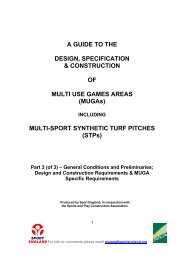View - North East Lincolnshire Council
View - North East Lincolnshire Council
View - North East Lincolnshire Council
You also want an ePaper? Increase the reach of your titles
YUMPU automatically turns print PDFs into web optimized ePapers that Google loves.
BOC Immingham Dissolved Acetylene Project Environmental Statement: Vol. 2 Main Text<br />
are Stallingborough (~1.8 km to the south west), Healing (~2.3 km to the south south west),<br />
Immingham (~3 km to the north west) and Grimsby (~3 km to the south east). The nearest<br />
residential receptor is Poplar Farm on South Marsh Road, approximately 550 m south west of the<br />
site (see Figure 11.1). Other isolated residential properties are located within 1.3 km of the site, as<br />
summarised in Table 6.2 below.<br />
Table 6.2 Nearby Residential Properties<br />
Property Name Distance from Site (a) (m)<br />
Poplar Farm, South Marsh Lane 550<br />
Grasmere, <strong>North</strong> Moss Lane 770<br />
Brickfield House, South Marsh Road 1,000<br />
Brickyard Cottage, South Marsh Road 1,050<br />
Eleanor House, Ephams Lane 1,220<br />
Primrose Cottage, Marsh Lane 1,260<br />
Table Notes:<br />
a As measured from nearest corner of development site<br />
Ecological Receptors<br />
6.48 A review of statutory ecological designations within a 10 km radius of the project site has identified<br />
the Humber Estuary SSSI, SAC, SPA and Ramsar site to be the nearest relevant location, located<br />
approximately 1 km to the north east of the site. The primary reasons for the SAC designation are<br />
the presence of Annex 1 Habitats. The Humber Estuary SPA covers virtually the same area as the<br />
Humber Estuary SAC, but is designated under the Birds Directive due to its importance in<br />
protecting and conserving certain European wild bird populations and their habitats, as well as<br />
protecting migratory birds and those considered rare or vulnerable.<br />
6.49 The Estuary comprises component habitats of intertidal mudflats and sand flats and coastal salt<br />
marsh. The salt marsh habitat and sand dunes are potentially sensitive to air pollution and are<br />
therefore considered in the assessment.<br />
6.50 There may be salt marsh present within the Pyewipe Mudflats (approximately 1 km from the<br />
development site); however, the closest sand dunes are at least 4 km from the development, on<br />
the northern banks of the Humber, and are therefore extremely unlikely to be affected by facility<br />
emissions.<br />
6.51 The background ammonia concentration within the SAC at its closest point to the site is 1 µg/m 3<br />
(three year average concentration, APIS 23 website) compared to a critical level of 3 µg/m 3 .<br />
Ammonia can contribute to nitrogen deposition; the critical load range for saltmarsh is 20 to 30<br />
kg/ha/year. The existing deposition rate for nitrogen at this location is 16 kg/ha/year (i.e.<br />
background levels are below the lower critical load for salt marsh).<br />
6.52 Apart from the Humber Estuary SSSI, there is only one other SSSI within 10 km, <strong>North</strong><br />
Killingholme Haven Pits, which is situated on the south bank of the Humber Estuary near<br />
Immingham. The main reasons for notification of these pits are their importance as large saline<br />
lagoons with an exceptionally rich fauna, and their significance as roosting and feeding grounds<br />
for waterfowl, which occur in internationally important numbers in the Humber Estuary in winter.<br />
Further information on the ecological designations and receptors is provided in Chapter 10.<br />
5100935.404 Environmental Statement August 2011 77




